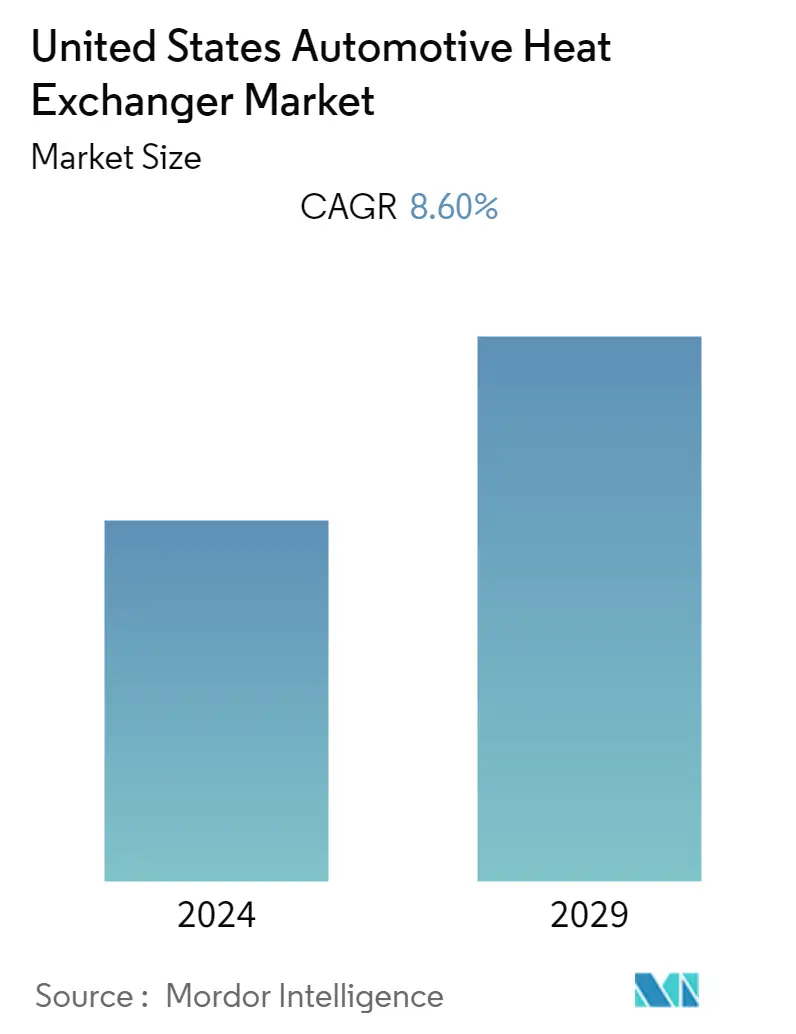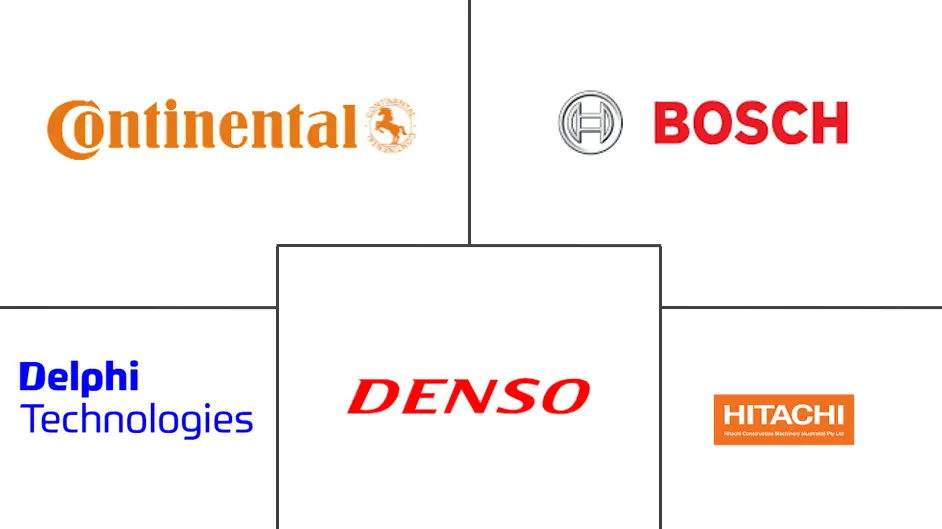Market Size of United States Automotive Heat Exchanger Industry

| Study Period | 2019 - 2029 |
| Base Year For Estimation | 2023 |
| Forecast Data Period | 2024 - 2029 |
| Historical Data Period | 2019 - 2022 |
| CAGR | 8.60 % |
| Market Concentration | Low |
Major Players
*Disclaimer: Major Players sorted in no particular order |
US Automotive Heat Exchanger Market Analysis
The United States Automotive Heat Exchanger Market is expected to register a CAGR of about 8.6 % during the forecast period (2020 - 2025).
An automotive heat exchanger is used to transfer heat between two mediums at different temperatures that are in thermal contact with each other. For instance, in an internal combustion engine, the engine coolant flows in a circular motion through the radiator coils, and air flows past these coils to cool the engine. By the end of 2014, the automotive segment had acquired more than a 25% share in the global heat exchanger market.
The US automotive heat exchanger market is the most significant contributor in the global heat exchanger market. With stringency in the CAFÉ regulations regarding emission standards, the automakers are obtaining components, including aluminium heat exchangers, critical to the manufacturing of lightweight vehicles. The increasing demand for automotive parts had a direct influence on the need for automotive heat exchangers market.
The automotive radiator leads the Market with a share of more than 55% in the application type. The shell and tube type heat exchangers accounted for the largest share in the US heat exchangers market with extrusion/fin heat exchangers growing at a significantly high rate. However, previous designs and structures of the heat exchanger have caused corrosion, decomposition, settlement of sludge, and dust particles have led to fouling, which results in reduced heat transfer and restricted throughput, and this leads to higher fuel consumption.
US Automotive Heat Exchanger Industry Segmentation
The United States Automotive Heat Exchanger Market covers the current and upcoming trends with recent technological development. The report will provide detailed analysis on various areas of the Market by application, design, vehicle, and powertrain type. The market share of significant manufacturers across the United States Market will be provided in the report.
| Vehicle Type | |
| Passenger Car | |
| Commercial Vehicle |
| Application | |
| Radiators | |
| Oil Coolers | |
| Intercoolers | |
| Air Conditioning | |
| Others |
United States Automotive Heat Exchanger Market Size Summary
The United States automotive heat exchanger market plays a pivotal role in the global heat exchanger industry, driven by the increasing demand for lightweight vehicles and stringent emission regulations. Automotive heat exchangers, essential for transferring heat in vehicles, are witnessing a surge in demand due to the rising production and sales of electric vehicles, supported by government incentives and policies aimed at achieving zero-emission standards. The market is characterized by a significant share of automotive radiators and shell and tube type heat exchangers, with a notable growth in extrusion/fin heat exchangers. However, challenges such as corrosion, fouling, and the availability of critical raw materials like copper and aluminum pose concerns, impacting pricing and manufacturing costs.
The market landscape is competitive and fragmented, with major players like DENSO Corporation, Hanon System, and Valeo actively investing in lightweight materials to enhance demand. The shift towards smaller engine sizes and the increasing popularity of two and three-cylinder engines are further propelling the need for automotive heat exchangers. Despite the challenges, manufacturers are focusing on technological advancements and partnerships with automotive companies to maintain a competitive edge. The ongoing transition towards electric vehicles and the emphasis on fuel efficiency are expected to drive the growth of the automotive heat exchanger market in the United States, making it a crucial segment in the automotive industry.
United States Automotive Heat Exchanger Market Size - Table of Contents
-
1. MARKET DYNAMICS
-
1.1 Market Drivers
-
1.2 Market Restraints
-
1.3 Porters Five Force Analysis
-
1.3.1 Threat of New Entrants
-
1.3.2 Bargaining Power of Buyers/Consumers
-
1.3.3 Bargaining Power of Suppliers
-
1.3.4 Threat of Substitute Products
-
1.3.5 Intensity of Competitive Rivalry
-
-
-
2. MARKET SEGMENTATION
-
2.1 Vehicle Type
-
2.1.1 Passenger Car
-
2.1.2 Commercial Vehicle
-
-
2.2 Application
-
2.2.1 Radiators
-
2.2.2 Oil Coolers
-
2.2.3 Intercoolers
-
2.2.4 Air Conditioning
-
2.2.5 Others
-
-
United States Automotive Heat Exchanger Market Size FAQs
What is the current United States Automotive Heat Exchanger Market size?
The United States Automotive Heat Exchanger Market is projected to register a CAGR of 8.60% during the forecast period (2024-2029)
Who are the key players in United States Automotive Heat Exchanger Market?
Continental AG, Robert Bosch GmbH, Delphi Automotive PLC, Denso Corporation and Hitachi, Ltd. are the major companies operating in the United States Automotive Heat Exchanger Market.

